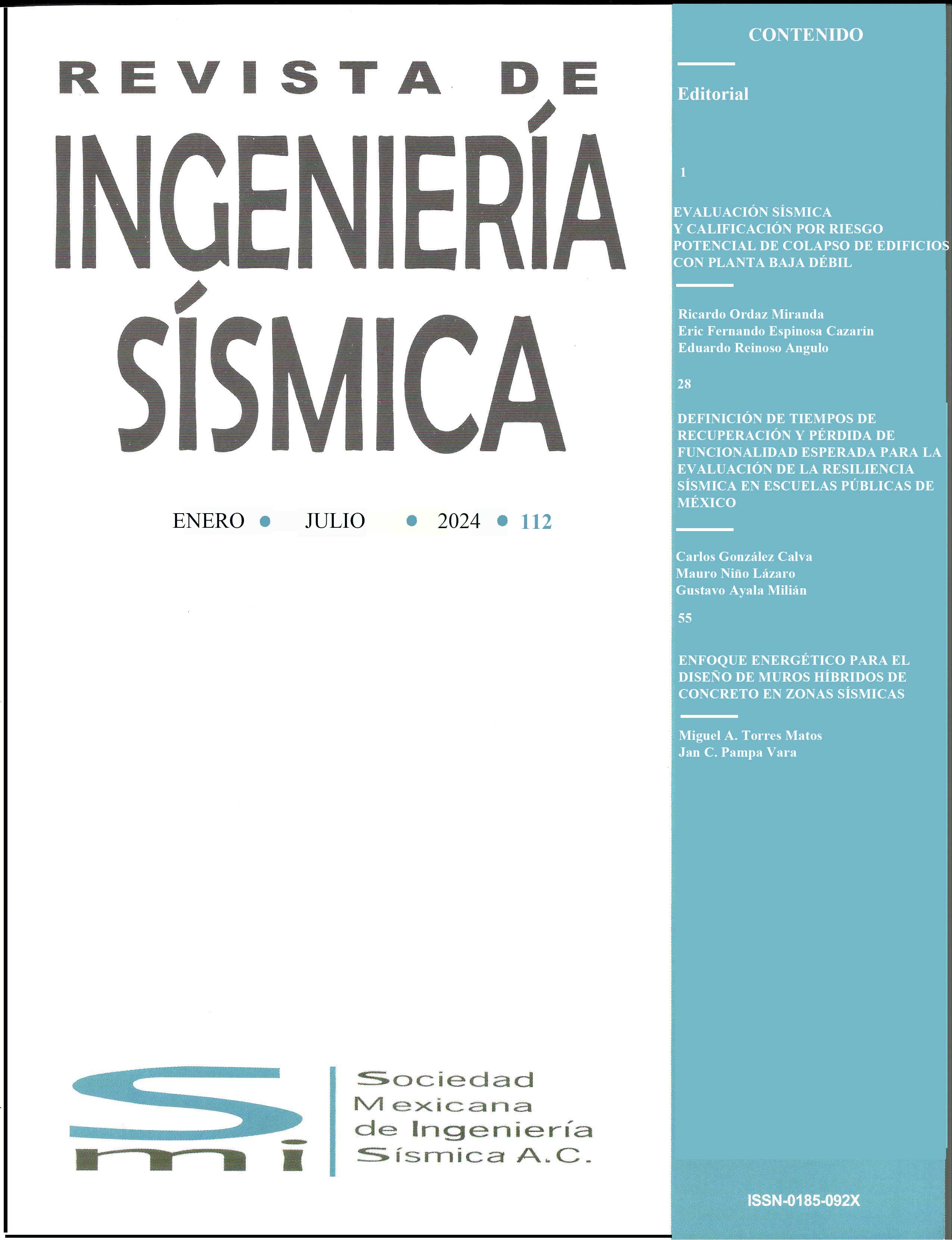NEW EXPRESSIONS ADOPTED BY MEXICAN CODE (NTCM, 2017) TO CALCULATE THE SHEAR STRENGTH OF INFILL MASONRY WALLS
DOI:
https://doi.org/10.18867/ris.100.531Abstract
The new shear strength design expressions for infill-walls included in the 2017 release of the Mexican code are presented. Three failure modes are considered, crushing, sliding and diagonal tension. The expressions were adapted from those specified in the Canadian masonry code, to include the Mexican code strength parameters and to make the expressions refer, for the three failure modes, to a shear resistance. It was verified that the shear strength given by the new expressions is satisfactory after comparing their prediction to the results of an experimental campaign that is also presented herein.
The experimental investigation included six specimens, scaled 1:2, in which the study variables were the wall to frame stiffness ratio, the use of confining elements and horizontal reinforcement. The results indicate that the wall to frame stiffness ratio has an important effect on the cracking strength of the walls and the maximum shear strength of the system. Moreover, the contribution of horizontal reinforcement to the lateral strength depends on the wall to frame stiffness ratio, a phenomenon that the design expressions do not take into consideration. The confining elements surrounding the infill walls do not increase the lateral strength nor the displacement capacity of the system; however, they enhance the out of plane stability of the wall and the contact conditions between the wall and frame.
Downloads
References
Aguilar, G y S M Alcocer (2001), “Efecto del refuerzo horizontal en el comportamiento de muros de mampostería confinada ante cargas laterales”, Informe Técnico, Centro Nacional de Prevención de Desastres, México.
Asteris, P G, S T Antoniou, D T Sophianopoulos y C Z Chrysostomou (2011), “Mathematical macromodeling of infilled frames: state of the art”, Journal of Structural Engineering, Vol. 137, No. 12, pp 1508-1517. DOI: 10.1061/(ASCE)ST.1943-541X.0000384
Asteris, P G, D J Kakaletsis, C Z Chrysostomou y E E Smyrou (2011), “Failure modes of in-filled frames”, Electronic Journal of Structural Engineering, Vol. 11, No. 1, pp 11-20.
Bazán, E (1980), “Muros de mampostería ante cargas laterales”, Tesis de doctorado, Universidad Nacional Autónoma de México, México D.F.
Canadian Standard Association CSA (2014), “Design of masonry structures”, S304-14, Ontario, Canada.
Crisafulli, F J (1997), “Seismic behavior of reinforced concrete structures with masonry infills”, Tesis de doctorado, University of Carterbury, New Zealand.
El-Dakhakhni, W W, M Elgaaly y A A Hamid (2003), “Three-strut model for concrete masonry-infilled frames”, Journal of Structural Engineering, Vol. 129, No 2, pp 177–185. DOI: 10.1061/(ASCE)0733-9445(2003)129:2(177)
FEMA (1997), “NEHRP commentary on the guidelines for the seismic rehabilitation of buildings”, FEMA-274, Washington, DC.
FEMA (1998), “Evaluation of earthquake damaged concrete and masonry wall buildings: Basic procedures manual”, FEMA-306, Washington, DC.
Flanagan, R D y R M Bennett (2001), “In plane analysis of masonry infills material”, Practice Periodical on Structural Design and Construction, Vol. 6, pp 176-182. DOI: 10.1061/(ASCE)1084-0680(2001)6:4(176)
Holmes (1961), “Steel frames with brickwork and concrete infilling”, Proceedings of the Institution of Civil Engineers, Vol. 19, pp. 473-478. DOI: 10.1680/iicep.1961.11305
Leal, J M (2010), “Propiedades físicas y mecánicas de la mampostería de block producido en la ciudad de Culiacán”, Tesis de licenciatura, Universidad Autónoma de Sinaloa, Culiacán, Sinaloa.
Madia, F C y G A Parsekian (2011), “Modeling a reinforced concrete building frame with infill walls”, 11th North American Masonry Conference, Minneapolis, U.S.A.
Mainstone, R J (1974), “Supplementary note on the stiffness and strengths of infilled frames”, Building Research Station, Garston, UK.
Masonry Standards Joint Committee (2010), “MSJC code/commentary working draft”, U.S.A.
Mehrabi, A B, P B Shing, M P Schuller y J L Noland (1996), “Experimental evaluation of masonry-infilled R/C frames”, Journal of Structural Engineering, American Society of Civil Engineers, Vol. 122, No. 3, pp. 228-237. DOI: 10.1061/(ASCE)0733-9445(1996)122:3(228)
Meli, R (1973), “Behaviour of masonry walls under lateral loads”, 5th World Conference on Earthquake Engineering, Rome, Italy.
New Zealand Standard (2004), “Design of reinforced concrete masonry structures”, NZC 4230: Parte 1 y 2.
NTCM (2004), “Normas técnicas complementarias para diseño y construcción de estructuras de mampostería”, Gaceta oficial del Distrito Federal, México, D.F.
NTCM (2017), “Normas técnicas complementarias para diseño y construcción de estructuras de mampostería”, Gaceta oficial de la Ciudad de México, México.
Pérez-Gavilán, J J, L E Flores y S M Alcocer (2015), “An experimental study of confined masonry walls with varying aspect ratios”, Earthquake Spectra, Vol. 31, pp. 945–68. DOI: 10.1193/090712EQS284M
Pérez-Gavilán, J J y A I Cruz (2017), “Shear strength of confined masonry walls with transverse reinforcement”, 16th International Brick and Block Masonry Conference, Padua, Italia
Pineda, J A y S M Alcocer (2004), “Comportamiento ante cargas laterales de muros de mampostería confinada reforzados con malla de alambre soldado”, Informe Técnico, Centro Nacional de Prevención de Desastres, México.
Polyakov, S V (1956), Masonry in framed buildings: an investigation into the strength and stiffness of masonry infilling, (Godsudarstvenoe Isdatel'stvo Literatury Po Stroidal stvui Architecture. Moscow, 1956), Traducido por G. L. Cairns, 1963. National Lending Library for Science and Technology, Boston.
Rubio, L (2018), “Contribución del refuerzo horizontal a la resistencia a corte de muros confinados de piezas de arcilla extruida”, Tesis de maestría, Universidad Nacional Autónoma de México. Ciudad de México, México.
Stafford-Smith, B (1962), “Lateral stiffness of infilled frames”, ASCE Journal of Structural Division, Vol. 88, No. 6, pp. 183-199.
Stafford-Smith, B (1966), “Behavior of square infilled frames”, Journal of the Structural Division, Vol. 92, No 1, pp. 381–403.
Stafford-Smith, B (1967), “Methods for predicting the lateral stiffness and strength of multi-storey infilled frames”, Building Science, Vol. 2, pp. 247-257. DOI: 10.1016/0007-3628(67)90027-8
Stafford-Smith, B y C Carter (1969), “A method of analysis for infilled frames”, Proceedings of the Institution of Civil Engineers, Vol. 44, pp. 31-48. DOI: 10.1680/iicep.1969.7290
Zepeda, J A y S M Alcocer (2001), “Comportamiento ante cargas laterales de muros de ladrillo de arcilla perforado y multiperforado”, Informe Técnico, Centro Nacional de Prevención de Desastres, México.






